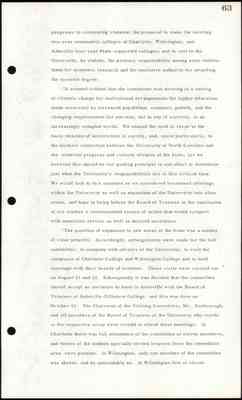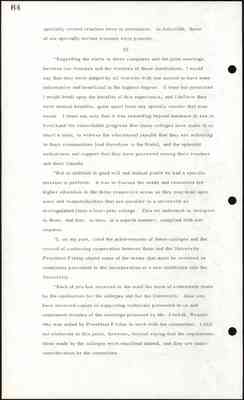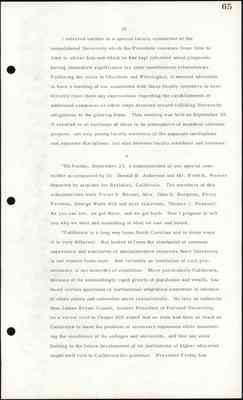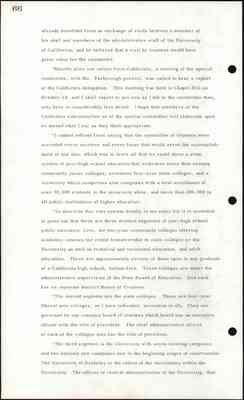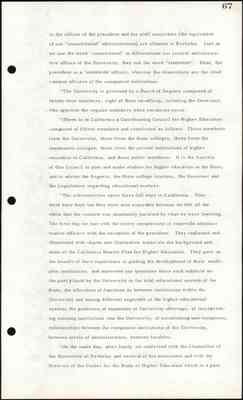Pages
63
programs to commuting students; the proposal to make the existing two-year community colleges at Charlotte, Wilmington, and Asheville four-year State-supported colleges; and to vest in the University, by statute, the primary responsibility among state institutions for academic research and the exclusive authority for awarding the doctoral degree.
"It seemed evident that the committee was working in a setting of climatic change for institutional arrangements for higher education made necessary by increased population, economic growth, and the changing requirements for success, not to say of survival, in an increasingly complex world. We sensed the need to recur to the basic mission of universities in society, and, more particularly, to the historic connection between the University of North Carolina and the material progress and cultural advance of the State, for we believed this should be our guiding principal in our effort to determine just what the University's responsibilities are in this critical time. We would look to this standard as we considered broadened offerings within the University as well as expansion of the University into other areas, and hope to bring before the Board of Trustees at the conclusion of our studies a recommended course of action that would comport with maximum service as well as desired excellence.
"The question of expansion to new areas of the State was a matter of clear priority. Accordingly, arrangements were made for the full committee, in company with officers of the University, to visit the campuses of Charlotte College and Wilmington College and to hold meetings with their boards of trustees. on August 21 and 22. These visits were carried out Subsequently it was decided that the committee should accept an invitation to meet in Asheville with the Board of Trustees of Asheville-Biltmore College, and this was done on October 12.
The Chairman of the Visiting Committee, Mr. Yarborough, and all members of the Board of Trustees of the University who reside in the respective areas were invited to attend these meetings. In Charlotte there was full attendance of the committee of eleven members, and twelve of the sixteen specially invited trustees from the immediate area were present. In Wilmington, only one member of the committee was absent, and he unavoidably so. In Wilmington five of eleven
64
specially invited trustees were in attendance. In Asheville, three of six specially invited trustees were present.
III
"Regarding the visits to these campuses and the joint meetings between our trustees and the trustees of those institutions, I would say that they were judged by all trustees with one accord to have been informative and beneficial in the highest degree. If time but permitted I would dwell upon the benefits of this experience, and I believe they were mutual benefits, quite apart from any specific results that may ensue. I must say only that it was rewarding beyond measure to see at first hand the remarkable progress that these colleges have made in so short a time, to witness the educational results that they are achieving in their communities (and therefore in the State), and the splendid enthusiasm and support that they have generated among their trustees and their friends.
"But in addition to good will and mutual profit we had a specific mission to perform. It was to discuss the needs and resources for higher education in the three respective areas as they may bear upon aims and responsibilities that are peculier to a university as distinguished from a four-year college. This we undertook to interpret to them, and they, in turn, in a superb manner, complied with our request.
"I, on my part, cited the achievements of these colleges and the record of continuing cooperation between them and the University. President Friday stated some of the terms that must be reviewed as conditions precedent to the incorporation of a new institution into the University.
"Each of you has received in the mail the texts of statements made by the spokesmen for the colleges and for the University. Also you have received copies of supporting materials presented to us and condensed minutes of the meetings prepared by Mr. Fred H. Weaver who was asked by President Friday to work with the committee. I will not elaborate at this point, however, beyond saying that the representations made by the colleges were excellent indeed, and they are under consideration by the committee.
65
IV
I referred earlier to a special faculty committee of the consolidated University which the President convenes from time to time to advise him and which he has kept informed about proposals having immediate significance for inter-institutional relationships. Following the visits to Charlotte and Wilmington, it seemed advisable to have a meeting of our committee with these faculty members to hear directly from them any expressions regarding the establishment of additional campuses or other steps directed toward fulfilling University obligations to the growing State. This meeting was held on September 20. It resulted in an exchange of ideas in an atmosphere of manifest common purpose, not only among faculty members of the separate institutions and separate disciplines, but also between faculty members and trustees.
V
"On Sunday, September 23, a subcommittee of our special committee accompanied by Dr. Donald B. Anderson and Mr. Fred H. Weaver departed by airplane for Berkeley, California. The members of this subcommittee were Victor S. Bryant, Mrs. John G. Burgwyn, Percy Ferebee, George Watts Hill and your chairman, Thomas J. Pearsall. As you can see, we got there, and we got back. Now I propose to tell you why we went and something of what we saw and heard.
"California is a long way from North Carolina and in many ways it is very different. But looked at from the standpoint of common experience and similarity of administrative structure their University is not remote from ours. And certainly an institution of such preeminence is not unworthy of emulation. More particularly California, because of its astonishingly rapid growth of population and wealth, has faced certain questions of institutional adaptation somewhat in advance of other states and somewhat more resourcefully. No less an authority than James Bryant Conant, former President of Harvard University, on a recent visit to Chapel Hill stated that no state had done as much as California to meet the problem of necessary expansion while maintaining the excellence of its colleges and university, and that any state looking to the future development of its institutions of higher education might well turn to California for guidance. President Friday has
66
already benefited from an exchange of visits between a member of his staff and members of the administrative staff of the University of California, and he believed that a visit by trustees would have great value for the committee.
"Shortly after our return from California, a meeting of the special committee, with Mr. Yarborough present, was called to hear a report of the California delegation. This meeting was held in Chapel Hill on October 14, and I shall report to you now as I did to the committee then, only here in considerably less detail. I hope that members of the California subcommittee or of the special committee will elaborate upon or amend what I say as they think appropriate.
"I cannot refrain from saying that the committee of trustees were accorded every courtesy and every favor that would serve the accomplishment of our aim, which was to learn all that we could about a state system of post-high school education that embraces more than seventy community junior colleges, seventeen four-year state colleges, and a university which comprises nine campuses with a total enrollment of over 50,000 students in the university alone, and more than 200,000 in all public institutions of higher education.
"To describe this vast system briefly is not easy; but it is essential to point out that there are three distinct segments of post-high school public education: first, the two-year community colleges offering academic courses for credit transferrable to state colleges or the University as well as technical and vocational education, and adult education. There are approximately seventy of these open to any graduate of a California high school, tuition-free. These colleges are under the administrative supervision of the State Board of Education. And each has its separate district Board of Trustees.
"The second segment are the state colleges. These are four-year liberal arts colleges, as I have indicated, seventeen in all. They are governed by one common board of trustees which board has an executive officer with the title of president. The chief administrative officer of each of the colleges also has the title of president.
"The third segment is the University with seven existing campuses and two entirely new campuses now in the beginning stages of construction. The University at Berkeley is the oldest of the institutions within the University. The offices of central administration of the University, that
67
is the offices of the president and his staff associates (the equivalent of our "consolidated" administration) are situated in Berkeley. Just as we use the word ' consolidated' to differentiate our central administrative offices of the University, they use the word 'statewide'. Thus, the president is a 'statewide' officer, whereas the chancellors are the chief campus officers of the component institutions.
"The University is governed by a Board of Regents composed of twenty-four members, eight of them ex-officio, including the Governor, who appoints the regular members when vacancies occur.
"There is in California a Coordinating Council for Higher Education composed of fifteen members and constituted as follows: Three members from the University, three from the State colleges, three from the community colleges, three from the private institutions of higher education in California, and three public members. It is the function of this Council to plan and make studies for higher education in the State, and to advise the Regents, the State college trustees, the Governor and the Legislature regarding educational matters.
"The subcommittee spent three full days in California. They were busy days but they were also enjoyable because we felt all the while that the venture was abundantly justified by what we were learning. The first day we met with the entire complement of statewide administrative officers with the exception of the president. They explained and illustrated with charts and illustrative materials the background and aims of the California Master Plan for Higher Education. They gave us the benefit of their experience in guiding the development of their multiplex institutions, and answered our questions about such subjects as: the part played by the University in the total educational system of the State; the allocation of functions as between institutions within the University and among different segments of the higher educational system; the problems of expansion of University offerings, of incorporating existing institutions into the University, of establishing new campuses relationships between the component institutions of the University, between levels of administration, between faculties.
"On the same day, after lunch, we conferred with the Chancellor of the University at Berkeley and several of his associates and with the Director of the Center for the Study of Higher Education which is a part
